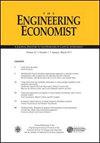“将交易向量划分为纯投资”的续集:交易具有唯一IRR的一个新的充分条件和IRR分布的一些结果
IF 1.2
4区 经济学
Q4 BUSINESS
引用次数: 1
摘要
摘要同一作者在2018年发表在《工程经济学人》上的一篇文章(第63(2)卷,143-157)证明,任何交易都可以唯一地划分为一系列内部收益率严格降低的纯投资。本文使用该结果来证明事务具有唯一IRR的新条件,并提供了一些关于事务的IRR必须如何分布的信息。本文章由计算机程序翻译,如有差异,请以英文原文为准。
Sequel to “partitioning transaction vectors into pure investments”: A new sufficient condition for transactions to have a unique IRR and some results on the distribution of IRRs
Abstract An article by the same author in The Engineering Economist in 2018 (vol. 63(2), 143–157) proved that any transaction could be uniquely partitioned into a sequence of pure investments with strictly decreasing internal rates of return (IRRs). This article uses that result to prove a new condition for a transaction to have a unique IRR and also gives some information on how the IRRs of a transaction must be distributed.
求助全文
通过发布文献求助,成功后即可免费获取论文全文。
去求助
来源期刊

Engineering Economist
ENGINEERING, INDUSTRIAL-OPERATIONS RESEARCH & MANAGEMENT SCIENCE
CiteScore
2.00
自引率
0.00%
发文量
14
审稿时长
>12 weeks
期刊介绍:
The Engineering Economist is a refereed journal published jointly by the Engineering Economy Division of the American Society of Engineering Education (ASEE) and the Institute of Industrial and Systems Engineers (IISE). The journal publishes articles, case studies, surveys, and book and software reviews that represent original research, current practice, and teaching involving problems of capital investment.
The journal seeks submissions in a number of areas, including, but not limited to: capital investment analysis, financial risk management, cost estimation and accounting, cost of capital, design economics, economic decision analysis, engineering economy education, research and development, and the analysis of public policy when it is relevant to the economic investment decisions made by engineers and technology managers.
 求助内容:
求助内容: 应助结果提醒方式:
应助结果提醒方式:


